- Article
gives origins of and steps taken to make Dhokra Art, why demand is falling and
what can we do.
India's cultural diversity comes to light in its various cultures. The country’s folk dances and handicrafts have successfully preserved its ancient art forms. One such art form is Dhokra Art (or Dokra Art). Before we dive into its making process, it will be worthwhile to know the history and origin of this fabulous ancient metal craft.
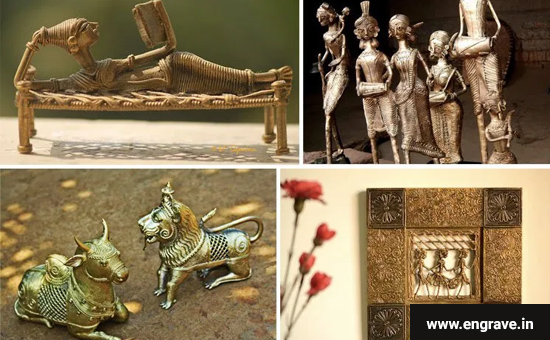
![]()
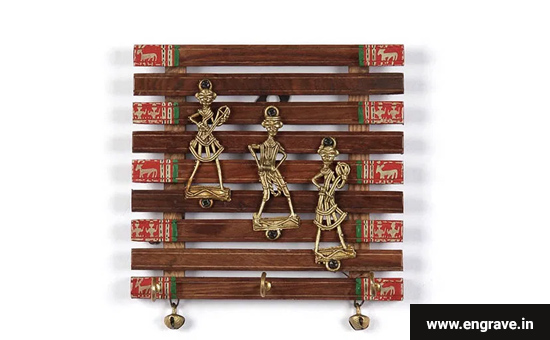
What is Dhokra Art?
The
art is a non-ferrous metal casting technique known as lost-wax casting or cire
perdue (in French). This technique has been known to be in existence for nearly
4000 years. A statue of a dancing doll excavated in Mohenjo-Daro is the oldest
known lost-wax technique artifact.
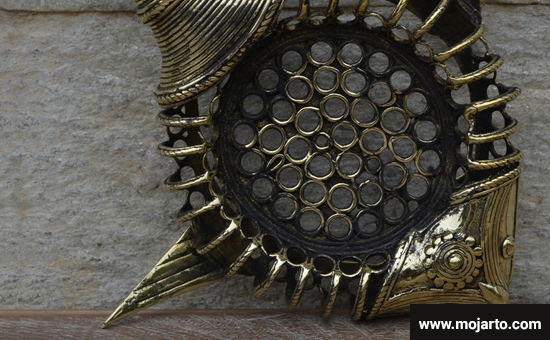
Where is Dhokra Art from?
The name ‘Dhokra’ is derived from the Dhokra Damar tribes of West Bengal who originally practised this art form. The metal casting artwork later spread its wings to the Central, Eastern and South India.
There
are two types of casting, Hollow Casting and Solid
Casting. The hollow casting is practised in Central and Eastern parts
which include Chhattisgarh, Madhya Pradesh, Jharkhand and West Bengal, while
the solid casting is practised in South India region including Telangana, which
was awarded GI tag (A geographical indication is a name or sign used on
products which corresponds to a specific geographical location or origin) for Adilabad Dhokra craft.
Dhokra
Crafts are created using Bell Metal which is an alloy of
Brass, Nickel and Zinc oxide. Even though the artifacts have their humble
beginnings in the clay core, they have, over the last few decades, gained
immense popularity globally.
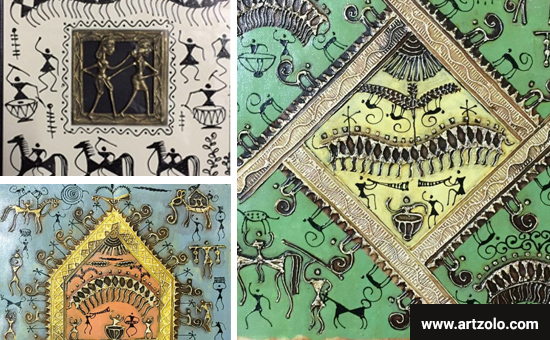
Let
us explore the thirteen steps involved in the creation of Dhokra
Art.
1. Creating the Mould
Step
1 - The first step in the creation of Dhokra metal art is the powdering
and sieving of Black mud, or Kaali mitti, which is later on used for creating
the core clay model. This process is usually performed by the female section of
the household.
Step
2 - A coarse clay mixture is created as it is mixed and kneaded with rice
husk.
Step
3 - Once the soil dough is ready it is moulded into a model which is kept
in the sun and dried out completely. This step is crucial to ensure that the composite
mould model is devoid of any excess water and can retain its shape throughout
the process. The model can also be dried by gently firing in the oven. This
clay-mud model is in shape of the final cast.
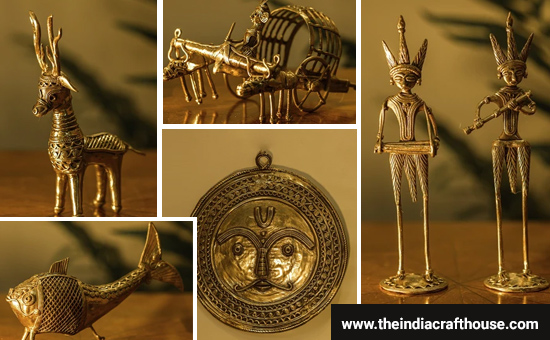
2. Preparing Beeswax Strands
Step
4 - A Beeswax or resin bundle is used for the next step in the process.
With the assistance of an ingenious tool called Thassa, thin strands are extracted from beeswax bundles through a sieve-like tool called ‘Pichki’. The artist draws threads (as thin as 1mm in diameter) out of the wax bundle which will be then used to wrap up the clay model. This is the most crucial step in the creation of Dhokra art as it requires continuous practice to perfect the art of drawing the beeswax into thin wires and wrapping them around the mould deftly.
3. Covering the Mould
Step
5 - The artist then creates a sticky solution of green beans leaves
colloquially known as sem and the mould is covered with it.
Step
6 - The strands created in step 4 are used to cover the mould completely.
Step 7 - Additional designs, patterns and ornaments are separately made using the wax bundle and then attached to the mould. The final design can be seen as taking shape in this stage. Tools like wooden spatula are used to smoothen out any rough surfaces of the mould.
4. Preparing the Outer Covering
Step
8 - In the next step, a mixture of clay, sawdust, and charcoal is created,
and the mould is covered with it. The ducts are set up for wax to drain out and
melted metal to take over the cavity left by the wax.
Step
9 - The mould is dried out in the sun once again and another layer of clay
is applied. When this layer is dry a final covering of rice husk and dengur is
given to the mould.
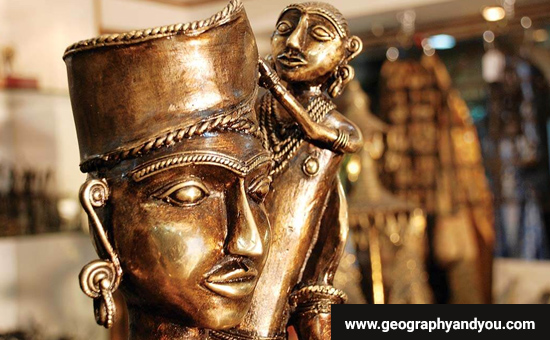
5. Baking the Mould
Step
10 - The mould is now ready for baking. The artist bakes the mould at high
temperatures rising up to nearly 1100 degrees Celsius. This process melts away
the wax leaving a fine cavity between the two layers of the clay mixtures.
To see pictures
of moulding
6. Pouring the Metal
Step
11 - Pieces of brass metal are melted and this molten metal is poured into
the cavity through the ducts. As the melted metal hardens, it takes over and
adorns the shape and design of the mould.
Step
12 - The mould is then left to cool down for at least two to three hours.
Regular
spraying of water helps hasten the cooling process. It also makes the mould softer
and easier to break open.
The Superb Final Product is now Ready!
Step
13 - The mould is broken with a hammer and the final product is ready to
add a finishing touch to. The artist uses various tools to brush, file and buff
the finished product enhancing its beauty.
It
is important to note that the Bell Metal art technique requires expertise and
talent to make sure that all the 13 steps are carried out skilfully. The artist
has to ensure that the mould retains its shape until the final step of the
process.
As
detailed above, the process is extremely elaborate and time-consuming. It requires
years and years of practice to master. Further, each mould can be used only
once, therefore, each finished product is different and unique. The final
artifact can be created perfectly only when the artist has mastered the skill
of working with clay as well as metal. This metallurgical form of creating art
is not just one of the oldest but is also considered as the most advanced in
its field. No wonder we are all still mesmerized by the quaint beauty of these
handicrafts.
Motifs Utilised
Dhokra
is an ancient art and the motifs continue to have a primitive simplicity to
them. Thus, commonly occurring motifs
are religious images, Dhokra horses, elephants, peacocks, owls, measuring
bowls, and lamp caskets, etc.
However, the ‘primitiveness’ of these motifs do not show a lack of growth or that that they are anarchic. Rather they might hide profound wisdom. Even someone like Carl Gustav Jung, one of the biggest psychologists reads much in these archetypical symbols that keep recurring in the simple motifs of Dhokra arts.
Moreover, some of these symbols have something quite modern to them. Of
particular notice is an ancient artifact of a Dancing girl, who has that flirtatious smile on her face as she stands with her hand on her hip.
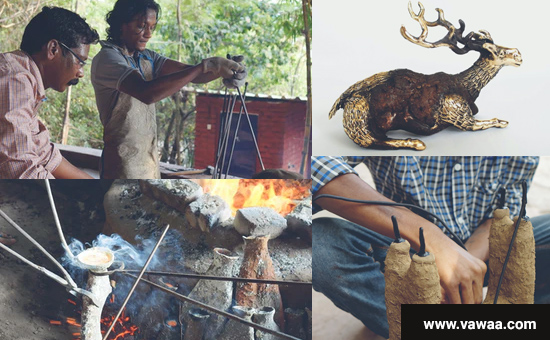
A Declining art
Dhokra art much like several other traditional arts is seeing a very fast decline. Unlike some of the other handicrafts that are declining in India, the problem with the Dokhra art is not a lack of demand. The demand is on the higher side – both domestically and internationally.
Rather
the problems are that first, the raw material is getting expensive. The
artisans are not always able to keep up with the increases in prices.
Secondly,
there are problems of logistics. The producers being small are unable to bring
their product to their consumers who are distant and often wide apart.
Thirdly,
with increased prices and logistics costs, the final artifacts themselves get a
bit too expensive and industrial products can often be cheaper.
Fourthly,
the industry remains untouched by any changes in technology. The artisans have
failed to use any mechanization to ease their load. There is a sort of
roughness to final products, a lack of final touch.
Fifthly, the newer generation is not showing much interest in art whose future seems a bit uncertain.
What can we do?
We
believe Dhokra art can be much helped by some marketing. The government could
use Dhokra artefacts to decorate government buildings. A government or
non-government agency might be created that will act as an intermediary between
artists and their customers. Some protection needs to be given to industry. And
research needs to be made in ways of improving the Dhokra technique.
Also
read about Dhokra Art
in Chattisgarh
Conclusion
Dhokra
art is an example of the ancient genius that has survived to this day despite
remaining unaffected by industrialization. It shows that art finds a way of
communicating itself whether or not there are technologies that support it. And
we hope it shall have a proposer as travellers are growing more and more
conscious of its importance.
References
and Also read
1. Lost wax casting
in India
2. The
Marvel of Adivasi Art
3. Bastar
Craft and Culture
4. Pictures of
Bastar Craft – shows making process of cast iron images.
To read all
articles by author
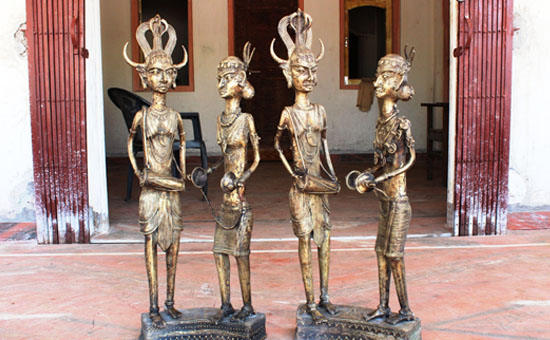 Cast Iron image, home of master craftsmen Dr Jaidev Baghel, Bastar. Pic 2013.
Cast Iron image, home of master craftsmen Dr Jaidev Baghel, Bastar. Pic 2013.
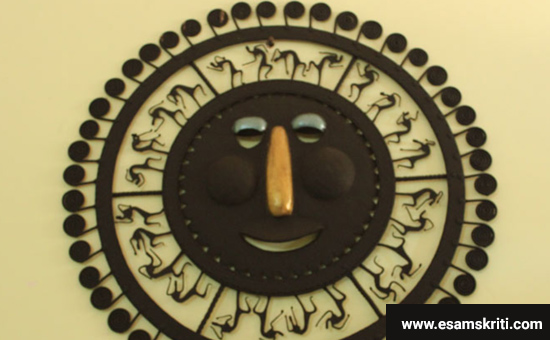 A wrought iron image in Tiku Ram home, Bastar. Pic 2013.
A wrought iron image in Tiku Ram home, Bastar. Pic 2013.
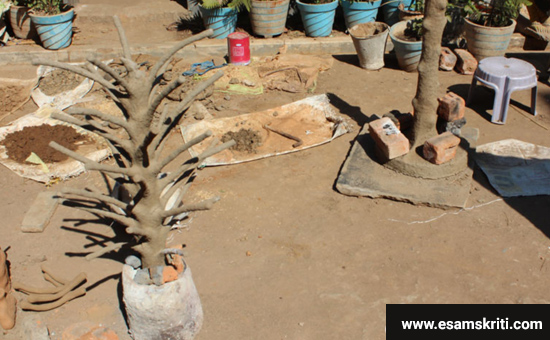 Work place of Dr Jaidev Baghel (expert in cast iron images) Kondagaon, Bastar.
Work place of Dr Jaidev Baghel (expert in cast iron images) Kondagaon, Bastar.
Detailed caption - Mould before
going into oven. Metal also melted in oven. Next metal poured on mould. When it
gets cold remove mud from image. U see two images kept for drying before it is
sent to the oven. When the two are joined final product is ready. Album
shows Lost Wax process called Cire Perdue in the West.
Last three pics by Sanjeev Nayyar.
The
purpose of this compilation is to document and promote. We have given credits
and reference links in this compilation. In case some are missed, it is not
with malafide intent.